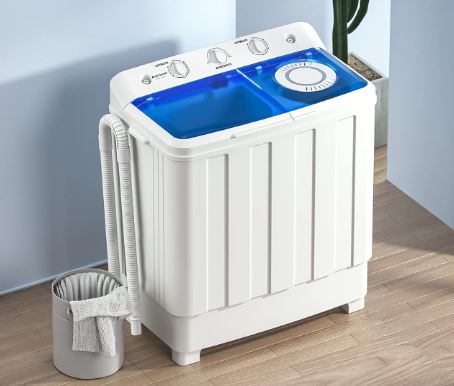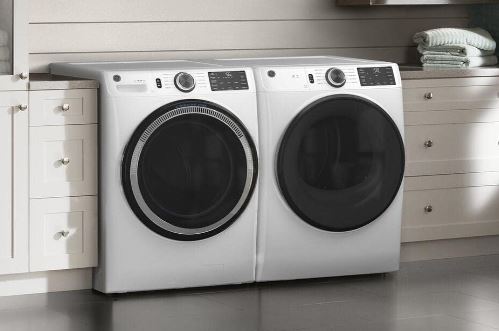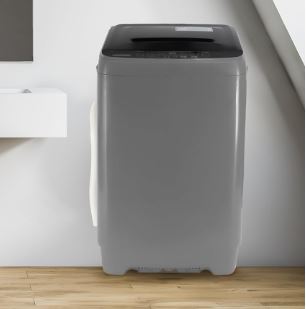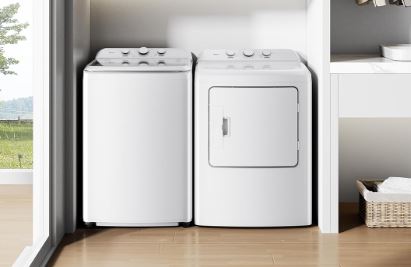Several functions must work harmoniously for the washing machine to do its job thoroughly; perfect examples are agitation, spinning, and draining. But what if your washing machine will not agitate but will spin and drain?
If your washing machine doesn’t agitate but spins and drains, it’s likely due to a failed component. These components include the agitator, lid switch, washer transmission, timer, drive block, and motor coupling, which you should inspect.
But why is agitation so important? During agitation, the laundry rubs against the agitator (tall spindle at the washer’s drum) and helps break up stains and soiled parts, cleaning your laundry.
This guide shall discuss the seven reasons why your washer fails to agitate but will drain and spin and how to troubleshoot them. Let’s get started!

In a rush? Below is a summary of why your washing machine fails to agitate but spins and drains.
Quick Fixes for a Washing Machine That Won’t Agitate But Will Spin and Drain
| – | Faulty Part | Quick Fix |
| 1. | Agitator | Replace a broken agitator. |
| 2. | Lid Switch | Test the lid switch with a multimeter device and replace it if it shows no continuity. |
| 3. | Transmission | Replace the transmission if the washer makes a loud whining sound. |
| 4. | Drive Block | Replace a worn-out drive block. |
| 5. | Timer | Test the timer’s contacts with a multimeter and change it if it fails the continuity test. |
| 6. | Drive Motor | Test the drive motor’s contacts with a multimeter and replace the motor if it fails the continuity check. |
| 7. | Motor Coupling | Replace the drive motor if the washer fills up and spins but doesn’t agitate but makes a clicking sound. |
7 Reasons Your Washing Machine Will Not Agitate But Will Spin and Drain
Below are the reasons why your washing machine will not agitate but will drain and spin:
1. Broken Agitator
The agitator itself is the first part to blame when your washer spins and drains a bit and fails to agitate. It’s the tall middle spindle in top load washers and is the centerpiece that facilitates agitation.
The part helps move the clothes in the water in each wash cycle. The agitator or its components may fail or wear out naturally in over-prolonged usage or older washers.
DIY Fix
If the agitator is broken, you need to replace it by following the steps below:
- Unplug your washing machine from power
- Remove the top agitator cap
- Remove the inner cap (located directly below the top cap)
- Unscrew the agitator belt using a screwdriver
- Grab the agitator base with your hands and pull it upwards to remove the agitator
- Replace it with a new one and reverse the steps above after installing the new agitator securely in place
2. Defective Lid Switch
Another culprit for a non-agitating washer is the lid switch. This switch triggers the wash cycle to start when the lid closes perfectly. It thus acts as a safety mechanism and may stop your washer once it senses an unlatched door or when the lid opens abruptly.
The lid switch can wear naturally, or its end can come quicker if you habitually slam your washer door. To be sure the lid switch is at fault, you need to test it, which is something you can do yourself.
DIY Fix
To test the lid switch, you need a multimeter. Once you have it, you should follow the easy steps below:
- Unplug your washer from power
- Then locate the lid switch (near the top, in the upper left corner under the washer’s top panel)
- Remove the lid switch wire harness and remove the switch from its slot
- Set the multimeter to read in its lowest ohms setting (the RX1 or X1 mode)
- Touch the switch wire terminal probe and check the reading
- The reading for a working lid switch should be between 500 – 1,500 ohms
- If you get any other readings, you need to replace the lid switch

3. Transmission Failure
The washer’s transmission assembles pulleys and gears and helps transition the washer during cycles. Before concluding a transmission failure, you should listen to your washer sound while spinning.
If you hear whining noises, that’s an indication that the washer transmission is going bad. That also means your washer won’t agitate but will spin and drain.
But should you be in a hurry to change the transmission?
The answer is no! It should be your last resort. This is because the replacement part and the repair cost are equivalent to buying a new washing machine (View on Amazon).
But if you are the handy type like me and want to bypass the expensive repair cost, you can fix the issue yourself.
DIY Fix
Replace the transmission by following the steps below:
- Unplug your washer from power
- Using a screwdriver, remove the cabinets screws and pull the cabinets out
- Locate the transmission and plug the cable back, power it on, run a wash cycle, and check carefully if the transmission is at fault.
- If the transmission makes whining noises, it’s at fault (you can also check for signs of oil leak)
- Power off the washer again, remove the transmission and replace it with a new one and screw back the cabinets.
4. Worn-Out Drive Block
The washer drive block connects the agitator to the transmission and aids agitation. In many cases, the transmission block wears out naturally, and your washer will fail to agitate when it happens.
What happens is that the transmission shaft will continue to move back and forth, but the washer agitator won’t move or will move slowly.
You can tell a defective drive block if the basket wobbles, making a rattling noise, which may also affect spinning.
But before replacing the drive block, check the spanner nut that holds the spin basket (under the agitator if it’s loose). If it’s wobbly, tighten it. However, if it’s tight and the basket still wobbles, replace the drive block.
DIY Fix
Replace the drive block by following the steps below:
- Unplug your washer from power
- Open the control console
- Remove the cabinet
- Take out the tub ring
- Remove the agitator
- Take out the spin basket to access the drive block
- Once you get hold of it, remove it and install the new drive block
- Reverse the steps to get everything back in position
5. Timer Failure
The timer controls the drive motor, which connects to the agitator indirectly. It enables the motor to turn on and move as it supplies sufficient power.
The timer may fail electrically, so the motor won’t receive the power needed to move it in the right direction. The result will be that your washer will fail to agitate and spin.
DIY Fix
You should test and replace the timer if faulty by replacing the following steps:
- Disconnect your washer from power
- Remove the control and rear panel to access the timer
- Set the multimeter to RX1
- Ensure the probes touch the motor terminals
- You should receive a reading of zero or any figure nearing zero
- If you get different readings, replace the timer

6. Defective Drive Motor
If your washing machine drains and spins but won’t agitate, the chances of a defective motor could be high. The motor function is to drive the transmission, which in turn oscillates the agitator to cause agitation.
The good news is that you can identify a faulty motor by listening to your washer’s sound while spinning, especially a knocking noise.
Also, constant overheating or extreme power loss could describe a failing motor. Still, the motor needs a replacement if your washer fails to agitate.
DIY Fix
Replacing the motor is not an easy task. However, if you have DIY skills, you can replace your washer motor by following the steps below:
- Start by unplugging your washer from power
- Locate the motor and remove the two wires from their wiring harness
- Then set your multimeter to RX1 and touch the probes to the motor terminal
- You should receive a zero reading. If you get anything different, you should replace the motor
- Now, unscrew all the screws securing the washer motor and remove the old motor
- Install the new motor, attach it to its position, and reconnect its wiring harness
- Restore power to the washer and run a cycle to ensure it functions appropriately and if agitation takes full effect
7. Failed Motor Coupling
Sometimes, your washing machine motor coupling can fail, causing your washer not to agitate. The motor coupling links the drive motor to the washer transmission. Motor coupling is prone to fail if you habitually overload the washer.
The coupling goes between the transmission and the motor. If your washer fills with water but fails to agitate, but the motor is running, the motor coupler is the problem.
You can tell the motor coupler is bad if your washing machine makes clicking noises or the sound of broken pieces spinning around.
DIY Fix
You should replace the motor coupler if it is defective by following the following steps:
- Shut off the power to the washer or unplug it from power
- Open the control console
- Remove the cabinet
- Release the drain pump
- Remove the drive motor
- Remove the drive motor
- Remove the old motor coupler
- Install the new motor coupler
- Reinstall the drive motor, durian pump, cabinet, and control console, power back the washer, and run a wash cycle.
Washing Machine Won’t Agitate or Spin
Your washing machine will sometimes fail to agitate and spin due to a worn-out drive block, timer failure, defective drive motor, faulty lid switch, or transmission failure. That means that the reasons why your washer fails to agitate are the same reasons why your washer fails to spin.

People Also Ask
1. How Do You Fix a Washer That Is Not Agitating?
You can fix a washing machine that won’t agitate by:
- Replacing the agitator if broken
- Replace the agitator
- Change the lid switch if it lacks continuity
- Replace the drive block if faulty
- Check the timer’s continuity and replace it if it shows no continuity
- Change a bad motor
2. How Do You Reset the Agitator On a Washing Machine?
Resetting your washing machine agitator is the same as resetting your washer. That means these simple steps:
- Unplug your washer from power
- Wait for at least 5 minutes
- Connect your washer back to power, and it should reset
Concluding Thought:
Now you know what parts to check when your old washing machine will not agitate but will spin and drain. We are discussing the agitator, lid switch, transmission, drive motor, timer, drive motor, and motor coupling.
Check the agitator for breakages, the drive block for wear, and the transmission and motor coupling for malfunction. Meanwhile, use the multimeter to check the rest (lid switch, timer, and drive motor) with a multimeter to replace them if they fail the continuity check.
Also Read:
